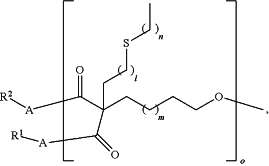| CPC A61K 51/065 (2013.01) [A61K 31/519 (2013.01); A61K 49/0423 (2013.01); A61P 35/00 (2018.01); C08G 63/6882 (2013.01); C08G 83/002 (2013.01)] | 14 Claims |
|
1. A method of identifying a solid tumor cell target, comprising,
1) contacting a cell with an effective amount of a composition comprising at least one polymeric nanoparticle conjugated with a targeting ligand that is a substrate for a solid tumor-specific cell protein, wherein the nanoparticle further comprises an imaging compound and an anti-cancer agent; wherein the polymeric nanoparticle comprises a hyperbranched polyester and/or polyamide polymer, wherein the hyperbranched polyester and/or polyamide polymer has the formula:
 wherein A is a heteroatom independently selected from nitrogen and oxygen; R1 and R2 are independently selected from hydrogen atom, substituted or unsubstituted alkyl, substituted or unsubstituted alkenyl, and substituted or unsubstituted alkynyl; 1 is an integer from 1 to 5; m is 0, 1, or 2; n is an integer from 1 to 5; and o is an integer from 2 or greater;
2) identifying one or more nanoparticles bound to the cells by using imaging devices; and optionally,
3) monitoring the solid tumor cell target by repeating 1) and 2).
|